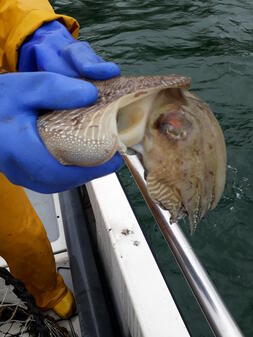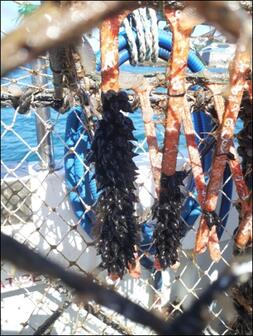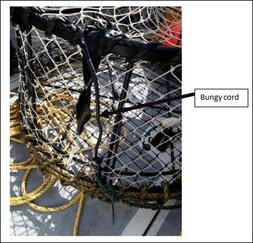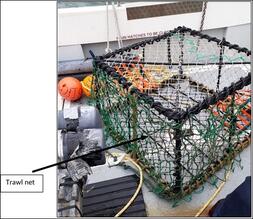Cuttlefish
Page review/updated 24/09/2023
BIOLOGY

The common cuttlefish (Sepia officinalis) is a marine mollusc within the class of Cephalopoda. It appears oval in cross section with a mantle length of up to 45 cm, and males are larger than females. It has a large head with relatively large eyes. Paired fins run from behind the head to the tip of the body. It has eights arms and two tentacles at the front of the head, the arms are specialised for grasping prey after the prey has been seized by the tentacles. The tentacles are cylindrical, muscular structures which can be quickly elongated to catch prey. The arms have rows of suckers along them, while the tentacles have several suckers at their end. Prey is transported to mouth parts that are formed of a structure resembling a bird’s beak. The skeletal mass of the cuttlefish is formed of a single internal ‘cuttlebone’. The cuttlebone is made of a porous structure which helps maintain buoyancy as well as providing structure.
The common cuttlefish has a relatively short life cycle of between 18 and 24 months. They are intermittent terminal spawners, whereby individuals lay eggs in separate batches. Mating is achieved by the male passing a packet of sperm using one of his arms, which is specially adapted for this purpose, to the female’s buccal membrane located above the mouth. In the English Channel, the spawning season extends from February to July in shallow inshore waters. The eggs, which are dyed black with ink, are attached in grape-like clusters to various seaweeds, seagrass, sessile animals, and artificial structures such as fishing pots. Hatching is usually at its highest in July and August. The hatchlings are similar to adults in morphology and basic behaviour but only 7-8mm in length.
One of the most unusual features of the cuttlefish is its colour changing ability. This is made possible due to three types of structures contained within its skin, called chromatophores, leucophores and iridophores, which are small structures filled with coloured ink which can be expanded and contracted to change colour. This can be used to communicate with others or to create patterns and textures used as camouflage. They can display at least thirteen types of body patterns from birth.
EGG LAYING MEDIA TRIAL

Cuttlefish are known to lay thousands of eggs on cuttlepots during the inshore cuttle fishery and there is a risk of these not remaining in the sea long enough to hatch. Eggs are often cleaned off throughout the cuttle season, and at the end of the season most fishers remove the pots and clean the eggs off them before they go into storage.
However, some fishers do leave their cuttlefish pots in the water to allow eggs to hatch. In Morbihan Bay in France an estimated 28 million eggs have been laid on pots over a three-year period, and in Sussex there was an average of 184 eggs found per trap. In Devon, under the CRESH project, 8,000 eggs were removed form three cuttlefish pots to re-locate them to allow them to hatch.

A pilot study was carried out by D&S IFCA to investigate the use of different media attached to the pots which cuttlefish could lay eggs on. Two cuttle pots were used to trial two different types of artificial egg laying media. One method involved attaching black and white bungy cords to one pot, and a piece of green trawl net was attached to the outside of the other pot.

This small-scale trial did not deliver definitive answers. This is most likely to be as a result of only two pots being deployed. Although this study was not successful, others have carried out similar research on a larger scale with positive results. For example, one study in the North Adriatic Sea found that using ropes which can be removed from the pots during the season, more than 20% of eggs can be saved without lowering the catch rates of the pots. Further information on artificial media on pots can be found here. This paper also reports on the impact study which D&S IFCA carried out for cuttle potting on seagrass.
CRESH PROJECT
D&S IFCA was a partner in a European Interreg IV Project entitled CRESH (Cephalopods Recruitment from English Channel Spawning Habitat). The project included many scientific studies and involved with numerous stakeholders from England and France. The research focused on cuttlefish and squid in the English Channel and investigated the different habitats used by different life history stages of pre-recruits (eggs and juveniles) for these two species. Objectives of the research were:
To improve understanding of the suitable habitat for Cephalopod reproduction.
* To evaluate the contribution of different spawning grounds to the stock recruitment.
* To investigate effects of temperature, abiotic and biotic factors on growth and survival of early stages.
* To develop genetic markers for identification of cephalopod paralarvae so as to understand species specific patterns in juvenile ecology.
* To combine fishery statistics and fishery independent data from England and France to update and refine stock and recruitment assessment.
* To generate new recommendations to fishermen and stakeholders for a sustainable use of English Channel marine resources.
Details of this project can be found on our Partnership Projects page.
Page reviewed: 22/02/2023
